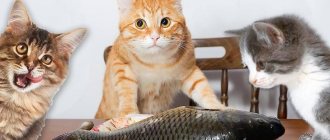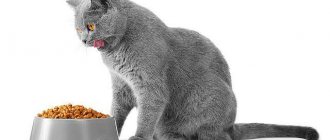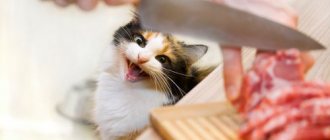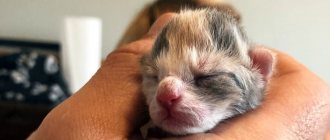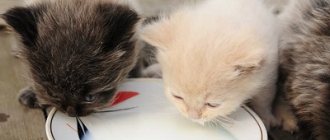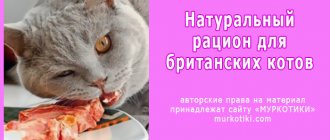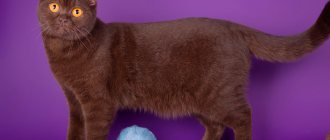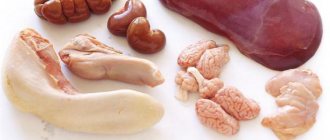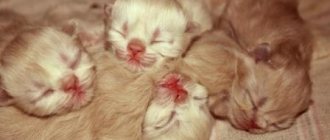British Fold kittens: what to feed at 6-12 months and later?
At the age of 6-12 months, the final formation of the pet’s character begins and puberty begins.
From an educational point of view, this is the most difficult period. In any case, you need to be calm and forgiving; after all, proper upbringing of both children and pets is not nerve-wracking. Last but not least, the degree of hooliganism of the kitten during this period depends on the correctness of its nutrition. If you have a British kitten or kittens, you need to figure out how to feed them during the period of 6-12 months. First of all, upon reaching 6 months, we completely remove milk from the diet - it is no longer needed, in addition, now it has become harder for the kitten to digest it. Otherwise, the list of products remains the same as in the previous period. You also need to gradually increase the proportion of dry food to 40-50% by the age of 12 months, and by the same age transfer your pet to 3 meals a day. Later, after reaching a year, you can gradually introduce him to 2 meals a day and 70% dry food; you should never exceed this figure. That's all - now you know what to feed your British kitten. Your pet is already big, beautiful and energetic. If you have followed and continue to adhere to the dietary recommendations given in this article, he will live a long, happy life and will never tire of delighting his owner with new tricks every day.
Choosing a place and utensils for feeding
Before the kitten arrives in the new home, it is advisable to equip a sitting and eating area. The choice of place and utensils for feeding plays an important role, since the feeling of comfort and safety determines how willing the kitten will be to eat in an unfamiliar environment.
The feeding area should be:
- Safe.
- Comfortable.
- Available.
- Clean.
To ensure your kitten feels safe, make sure he is not disturbed while he eats. If there are other animals in your home, during the adaptation period, feed the new pet separately.
To make your pet comfortable, you need to choose comfortable bowls. Stainless steel or ceramic bowls are ideal for feeding pets. Ceramic bowls are heavy, they do not slip on the floor and are easy to clean. Stainless steel bowls are more compact and can be treated with boiling water, but they slide on the floor, so it is better to place them on a stand.
At the stage of accustoming the kitten to a feeding schedule, the pet must be sure that it will get to the place of food at the usual time. If you feed your kitten in the kitchen, keep the doors open during the adaptation period. The door can be closed while the kitten is eating; the rest of the time, the pet should be able to approach an empty feeder and drinking bowl.
To keep the eating area clean, it must be covered with oilcloth or a rubber non-slip mat. Special mats solve several problems at once: they prevent injury if the kitten runs towards the bowl, make cleaning easier and prevent bowls from sliding on the floor.
Newborn kittens, what to feed
It happens that the cat abandoned the kitten, or died during childbirth, or the kitten needs to be separated from the cat for a while due to a blood group conflict. What to do, how to feed and care for it?
There is a special milk for kittens from birth:
- Cat milk replacer “Royal Canin Babycat Milk” (package contains 3 packets of instant milk, bottle, nipples, measuring spoon, detailed instructions);
- Beaphar Kitty's Milk;
- Goat's milk (as a last resort). Take a 5 ml syringe and break off the needle, put a rubber band from the pipette on the syringe, and make a couple of holes in the pipette with a needle.
Milk for kittens
Daily diet of Babycat milk
How many times to feed:
- The first week they feed every 2 hours (2 – 4 ml per feeding, 38 – 39°);
- From 2 weeks - every 3 - 4 hours (5 - 10 ml per feeding, 30 - 32°);
- From 3 – 6 weeks every 5 – 6 hours (10 – 15 ml per feeding, 26 – 28°).
The kitten is placed on its stomach on a warm heating pad at 38–40°, wrapped in a terry towel, and fed in this position. The kitten begins to suck when the first drop enters its mouth, then takes a break for a couple of minutes and eats the rest. The kitten is full if the rate of sucking slows down. Continuing to smack, he falls asleep; there is no need to force feed him. After feeding, massage the kitten’s tummy in the anus area with a folded wet disc until it empties; wipe the kitten’s face and butt with a damp disc 2-3 times a day.
Healthy newborn kittens weigh 80 – 120 grams, with a rectal body temperature of 37° (by seven weeks it will increase to 38 – 38.5°; to measure the temperature, you need to lubricate the end of the thermometer with Vaseline and slowly insert 1 cm into the kitten’s rectum and wait 3 minutes ). Daily weight gain in the first three weeks should be 10–20 grams.
This article provides recommendations from the nursery, as well as the maintenance, training, feeding, and care of cats from our British cattery.
How many times a day to feed
An adult cat is fed 3 - 4 times a day, we monitor the weight gain of a pregnant cat (we reduce the amount of food 1 - 1.5 weeks before giving birth).
A British cat should gain 1000 - 1500 grams during pregnancy; more is dangerous, because... the kittens will be large, which will lead to a difficult birth. The nursing mother should not be limited in food, she will eat as much as she needs, the norm should be introduced when the cat stops feeding.
- 3 – 4 weeks (monthly) – 1 time/day;
- 1 – 2 months – 2 times/day;
- 2 – 3 months – 3 times/day;
- 3 – 12 months – main feeding 3 – 4 times a day.
The norm in grams for dry food is indicated on the packaging depending on the weight and age of the pet.
The diet of a sterilized British cat or neutered cat is the same as that of a regular cat. Such animals are more likely to be overweight. If a cat (no matter what breed: British or Scottish Fold or Straight) has gained excess weight, it should be gradually transferred to a special food for sterilized ones.
Kitten health
Once you get a kitten, start listening to word of mouth
After all, it is very important to find YOUR veterinarian! Based on the advice of friends or reviews on the Internet, it will not be difficult for you to do this. At your first meeting, ask your future family doctor about nutritional recommendations, options for fighting parasites, the first signs of disease, and get a schedule of vaccinations and visits to the veterinarian
Deworming a kitten
About 7 days before the first vaccination you need to do deworming. Subsequently, kittens undergo this procedure every three months until one year. It is optimal to use broad-spectrum drugs for the prevention of parasites.
Flea control
Fleas are no joke. It’s especially not funny for the little ones who have these parasites. They cause itching, allergies, dermatitis, lead to exhaustion and the development of blood diseases! Have we scared you? Anti-flea products come in five types: drops, sprays, shampoos, collars, tablets. Do not rely on your choice if your pet is still very young, but consult your veterinarian.
Vaccination
IMPORTANT! It is necessary to vaccinate both animals that live in the yard and those that do not leave the apartment. Both the first and second can get sick equally, so it’s better to be safe
Kittens are vaccinated for the first time at the age of 8-9 weeks. In this case, vaccinations that do not contain the rabies virus are used.
Revaccination is carried out when the kitten is 12 weeks old. This complex vaccine already contains the rabies virus.
The next revaccination takes place once a year and then once every year.
The scheme may change slightly. Your veterinarian will suggest the best one.
Sterilization/castration of an animal
If you are ready for the fact that the kitten, as it grows up, will begin to “mark” its territory, demand a cat (cat) and regularly “bring it in,” then you don’t have to read any further. If this prospect does not make you happy, then let sterilization/castration be the most humane way to solve many future problems.
It is best to castrate a kitten at the age of 9-10 months.
A cat needs to be spayed before its first heat, which is approximately 8 months of age.
To conclude this chapter, we will tell you about the signs that mean your cat is having health problems.
So, what should you always pay attention to? Reasons to contact a veterinarian include: poor appetite, poor weight gain in the kitten, vomiting, bloating, diarrhea, runny eyes, pale gums, cough or shortness of breath, nasal discharge, difficulty urinating
At first glance, it seems that keeping a kitten is very, very difficult. In fact, this is a very pleasant thing, because the word “content”, if you regularly follow all our recommendations, will disappear from your diet and they will become just a way of life. And, believe me, when the fluffy ball settles on your lap and starts his endless “Purrrrrrr”, you will say that it was worth it!
We recommend reading very good books:
- Lyudmila Antonova “Care for domestic cats”;
- Elena Filipova “From a cat’s point of view.”
How about fish?
3. Cats should not be given fish often. Kittens can be given fish once a week, and adult cats no more than once every two weeks, but it is better to exclude it altogether from the diet of an adult cat. Give the fish boiled and without bones. In case of urolithiasis and other diseases of the urinary system, especially in castrated cats, exclude fish from the diet forever.
4. Mixing natural food and dry food is strictly forbidden. And if you feed a British cat with dry food, then adding natural food (meat, fish, vegetables) to the diet is also prohibited, as this can lead to diseases of the gastrointestinal tract and urinary system in the future.
To digest dry food and natural products in the cat's intestines, different enzymes and a completely opposite acidic environment are required. When these two completely opposite types of feeding are mixed, an imbalance occurs in the cat's stomach, and the liver suffers greatly from this double load. The cat’s intestines react differently and digest dry food and natural food, and simply do not have time to switch from one type of feeding to another, and this is fraught with a bunch of diseases in the future.
In general, the opinions of veterinarians and breeders differ on this matter, and they themselves feed their cats meat and porridge in the morning, and leave dry food in a bowl for the day. But “the facts are clear” and I will not feed my animal according to this scheme.
Tray and scratching post
Up to 6-8 months, the kitten often relieves itself and not always in the right place. This is normal, you can’t blame a growing Briton for this. Choose a tray with high sides, and if your pet loves privacy, then choose a closed toilet in the form of a house.
Suitable mineral and wood filler. Later you can switch to silica gel granules or abandon it altogether.
British kittens are trained to use the litter box right away. After eating, sleeping, active games, when they fuss and look for a secluded place, they are carefully taken to the tray. If the pet makes a puddle, then it is blotted with a napkin, which is placed in the tray.
A scratching post is also necessary for warming up your back. The best option is a post on a solid base with a rope. Some cats gravitate toward horizontal scratching posts or shag rugs. They should not have a strong odor; this scares the animal away and leaves negative memories in its memory for the rest of its life.
Attract the kitten's attention with a piece of treat, placing it on the scratching post. When he uses it, he is praised. As a last resort, tincture of valerian is dripped onto this equipment and the success of the venture is guaranteed.
Breed Features
Having studied the characteristics of the breed, you will know in advance what problems you may encounter as the kitten grows up. The British Shorthair cat is one of the most popular breeds all over the world. All British cats are similar to each other: they have a gray color, bright orange pigmentation of the eyes and erect ears. Any “derivatives” of the breed, for example, kittens with drooping ears, tabby or merle coloring, are mixed breeds.
A purebred British Shorthair cat with breeding documents is a potentially healthy animal. Before selling, the breeder is required to examine kittens for genetic diseases. Kittens that have been identified as having health problems are subject to castration, which makes it possible to maintain the health of the breed as a whole.
Hereditary genetic diseases of the breed are not very common, and their occurrence is due to the large population. It is known that British Shorthair cats are prone to food allergies, skin problems of various etiologies and rapid weight gain. The above characteristics of the breed must be taken into account when preparing the diet.
Ideal age to move
Many future owners want to monitor the growth and development of a British baby from an early period, at least from four weeks. But it is absolutely forbidden to take such a pet away from its mother.
By 12 weeks, a British kitten is more or less ready for independent living. It is at this age that the baby stops sucking mother’s milk, learns to eat solid food, and his own immunity begins to develop.
It is the mother who must do the weaning. If this procedure is carried out forcibly, then, in addition to health problems, behavioral disorders will certainly arise. Early weaning is also fraught with the development of diseases of the respiratory system, diarrhea and, as a result, dehydration.
Both vaccinations against panleukopenia, calcivirus and rhinotracheitis have already been carried out, which means the baby has immunity to these diseases.
The kitten is physically strong enough to move. At two or three months he received from his mother the skills of using a litter tray.
When parting with its mother early, the emotional state of a British kitten suffers greatly, since it is she who teaches how to communicate with people and other animals. A three- to four-month-old baby perceives new faces not with fear, but with curiosity. Therefore, it is worth listening to the opinion of the breeder and picking up a British kitten from the nursery at 12, and sometimes at 16 weeks.
Normal kitten weight
The first six months after birth are the most important in a kitten's life. It is during this period that you can understand how strong his physique will be in adulthood, as well as how much weight he will be able to gain.
There is no simple answer to the question of how much a British cat should weigh during the first six months of life, since each period has its own characteristics of development and weight gain. There is a special table that shows the weight of an animal of this breed depending on age. It is easy for British owners to navigate and check the development of their pet.
Much also depends on the proper care of the animal and its diet. Both factors have a strong impact on the weight of the pet.
The first days after birth
Newborn babies of Scottish and British breeds weigh almost the same. Their mass is quite large compared to other species, since adult pets are large individuals.
A kitten of this breed at birth will have a body weight in the range of 70–130 g. During the first 7 days of life, they gain weight well, becoming 1.5 times heavier.
In the first week after giving birth, the female should eat a lot of vitamins and minerals so that the offspring, through mother's milk, can receive everything they need for their growth and development.
In the second week
With proper and nutritious nutrition, a Briton should weigh 110–150 g by the second week of life. In just 7 days, this figure can increase by 1.5–2 times.
During this period, kittens are inactive and blind. They eat and sleep a lot, which contributes to good weight gain. During the second week, the animals reach 210 g. Some specimens were even able to gain 420 g. During this time, the babies gradually become more active and mobile. Some may even have their eyes opened.
Up to a month
After two weeks and up to 1 month, babies are gradually introduced to complementary foods. Its administration depends on the abundance of breast milk. The optimal time to start complementary feeding is 3–4 weeks. You should include canned cat food, chicken or beef, cottage cheese, sea fish, and a boiled egg (yolk only).
By the first month, the babies will gain another plus 250 g. Large kittens can grow well at this age and already weigh more than half a kilogram. This will be a normal indicator. It is optimal that by the 5th week the animals weigh on average about 600 g. At 8 weeks this figure can already exceed 700 g.
Three months
With proper nutrition, a British baby should weigh about 1 kg by 3 months. Every day the set is about 100 g. During this period, the body weight of animals depends on their gender. So, a cat should normally weigh 1–1.5 kg, and a cat should normally weigh a little more than 1.5–2 kg.
From natural products they need to be given:
- smoked sausages;
- pork, chicken;
- fermented milk products;
- river fish.
When it comes to dry food, you need to buy products from well-known companies (for example, Hills, Orijen, EVO), specially designed for growing young animals.
Four months
By the end of the third and beginning of the fourth month, British cats should weigh on average 1.7–2.4 kg, and male cats 2.1–3.9 kg. Over 4 months, the average normal weight for representatives of this breed is 2 kg. A lot here depends on diet. If your pet weighs more than 4 kg, you need to reduce the amount of food to prevent obesity.
Five months
During the fifth month, the animal usually increases its weight by 1.5–2 times. Normally, British people at this age should weigh 4.5 kg. To transform into an adult cat, your furry pet should gain the same amount.
How to care
The character and characteristics of little British dogs depend on genetic and individual characteristics. By their nature, the British are distinguished by strong immunity and endurance, cats are long-lived. And the health of pets is largely regulated by the care and nutrition of the baby.
Diseases that your pet may be exposed to:
- blindness;
- malocclusion;
- colds;
- skeletal changes;
- deafness;
- cryptorchidism.
In the process of caring for a kitten, helminth prevention and treatment for fleas and ticks should be carried out. The first vaccinations for British kittens begin with the process of getting rid of parasites.
Required vaccinations
To strengthen the immune system and prevent diseases, it is recommended to adhere to the vaccination schedule. At 1.5-2 m, vaccination against helminths is carried out, this is preparation for subsequent vaccinations.
The first vaccinations are given at 2-2.5 months. Vaccination is carried out in 2 stages. After the first stage, 3 weeks pass. This complex vaccination prevents diseases:
- Panleukopenia.
- Calcivirosis.
- Rhinotracheitis.
In the future, this vaccination is carried out once a year. A month after vaccination they are kept in quarantine: they are not taken out of the house.
Mandatory vaccination for British kittens is vaccination against rabies. Placed once a year.
Diet for a natural diet
It is not so difficult to choose the diet of a naturally-fed British kitten. If you have patience and awareness, then creating a menu for a teddy baby is not difficult.
First, remember that cats are carnivores, protein is very important for them. Even such seemingly pampered breeds of British cats need meat and offal no less than outbred kittens.
At 2 months, you can combine scraped meat with a teaspoon of milk rice porridge.
IMPORTANT: no spices, salt or sugar are added to kittens’ complementary foods. Products are served either lean boiled or frozen raw.
At three months, the British kitten's diet expands. He no longer feeds on his mother's milk, which means he must receive all the necessary substances from his own food. Necessary products for a 3 month old kitten include:
- Goat milk
- Lean beef (tenderloin, can be every day)
- Chicken fillet without skin, or thigh meat without fat (3-4 times a week)
- Cream up to 10% fat
- Rice or buckwheat porridge with milk (1-2 times a week)
- Cottage cheese, it is better if it is made independently from medium-fat kefir
- Chicken liver or hearts, but with trimmed fat (once a week)
- Grated vegetables: pumpkin, sweet potato, carrots, zucchini. (1-2 times a week)
- Small pieces of fruit: apple, pear, peach.
- Ryazhenka and kefir (2-3 times a week)
- Quail egg yolk (2-3 times a week)
- Boiled sea fish without bones (once a week)
- Baby purees from jars, both meat and vegetable (every day as a replacement for the meat or vegetable part of the diet)
At 4 months, a kitten can be introduced to unleavened cheese, but it should be given in very small quantities, no more than 10 grams per week. It is better to use it as a treat for a trip to the veterinarian for vaccinations or when teaching commands.
IMPORTANT: British kittens can eat berries, they are a good source of vitamin C
But it is better to give them from 5 months, in small pieces, and be sure to pay attention to the kitten’s reaction. Firstly, the baby may not like the taste of a particular berry, and secondly, watch out for an allergy
After a year, when the menu has become established, be sure to consult with your veterinarian about selecting a complex of vitamins and minerals. With a natural type of feeding, their additional source is required.
IMPORTANT: no matter what type of food you choose, your British kitten must have a bowl of clean water for drinking. It is better to change the water 2 times a day - morning and evening
https://youtube.com/watch?v=yOAd9g0r8ho
Which diet to choose: the pros and cons of “drying” and “natural”
The owner must decide immediately what to feed British kittens. You cannot mix or constantly change natural feeding and ready-made food. Even single-component holistic products are not recommended to be alternated with conventional products.
The good thing about ready-made food is that you can buy it in small wholesale at a pet store or order it on a specialized website. Also, a jar of kitten food is usually designed for a daily diet, which means you won’t overfeed your cat. And in general, a ready-made diet is always more convenient than preparing food for your cat every day.
But this is where the cost of feed comes into play. If you do not think through the diet in advance and do not purchase with maximum profit, then the nutrition budget for a British kitten can be significant. These breeds can only eat super-premium or holistic food, and they are not cheap.
The natural type of feeding also requires planning and preparation, but you can still combine purchases with your own daily consumption. For example, you can use all the milk suitable for kittens for baking. The kitten eats its portion from the package, and the impressive leftovers will always find use in human recipes.
The same goes for meat - lean turkey fillet can be easily processed into semi-finished products for a kitten; you can cook any excess for yourself. Vegetables, fruits, cereals - all these are products for general use that are not purchased selectively only for the kitten.
The issue of daily cooking can also be solved with natural feeding. There are a lot of recipes for cats that help you create a diet for several days, although you will still spend more time on them than on ready-made food.
One of the disadvantages of natural products is the need for self-dosing, because we must not forget about the daily amount of food and the volume of each serving. Evenness of food intake is very important for a small British kitten.
Also, with a natural diet for a British kitten, it is difficult to maintain the balance of vitamins, which are already collected in ready-made food, taking into account breed and age characteristics. A veterinarian will help you resolve the issue, especially if you keep a diary of your kitten’s food.
Review of ready-made feeds
If we are talking about raising an elite, purebred animal, you should pay attention to premium and super-premium products from the very beginning. Brands such as Royal Canin even have special food for British kittens in the British shorthair line
Products under the Acana and Chicken Soup brands are considered to be of even higher quality. Of the simpler brands, breeders recommend Hills and Pro Pac. Veterinarians advise owners of British cats to avoid creating an overly rich diet for their pets, since the breed as a whole is prone to gaining excess weight. If you choose a specific brand of food and canned food in pouches or jelly, then you should also choose this particular brand of pate in jars.
If you want to give your pet the best, you should pay attention to the highest-class grain-free product - Earthborn Holistic. The American brand produces a high-protein product with small granules, ideal for both kittens and adult cats.
Another option is Go! Natural, produced in Canada. They are also grain-free and contain a balanced combination of meat, vegetables, grains, fats, and vitamins.
The kitten's first days at home
It is important not to forget the simple rules for adapting a pet to your home. The little creature is scared, the animal was taken away from its mother and placed in an unfamiliar environment
New smells, sounds, food - absolutely everything is foreign to the plush ball. Necessary steps to acclimate a tiny family member:
- Separate a small room for the pet. There is no need to immediately leave the baby in a large apartment. Let it be a bathroom or a corridor. Later, as you adapt, you can open the doors to other rooms.
- By purchasing an animal from an experienced breeder, you get a pet that is accustomed to grooming skills. By 2-3 months the child already knows how to go to the toilet and litter tray. A napkin with the kitten’s urine is placed in the container: the baby will orient itself by the smell and quickly get used to the place. If the cat has stepped on upholstered furniture or carpet, the stain is immediately wiped away. Otherwise, there is a chance that the fidget will continue to shit anywhere.
- There is no need to shower your baby with toys, even those specially purchased for him in pet stores. Children are not allowed to grab, pull, or squeeze a purebred pet.
- It happens that the kitchen and toilet are located far from each other. To begin with, you can place feeding dishes next to the tray.
- They talk to the pet and call it by name.
- Fluffy is gradually accustomed to food.
Toys for a British kitten
Toys are very important for the British. They help not only to establish a connection with the owner, but also to the intellectual development of the kitten. Toys allow you to keep your baby occupied while the owner is away and protect him from his own curiosity. It can be:
- “teasers” to simulate hunting;
- developing;
- food;
- sound toys.
Master classes: how to make toys for a kitten
To make a teaser on a string you will need:
- felt;
- strong thread;
- thread and needle.
It’s easy to make such a toy:
- Cut two pieces of the same shape from felt;
- Sew them tightly with thread. Before this, you can put dry lavender or catnip inside - this will make the kitten even more attracted to the toy.
- Sew a thread on which the toy will hang.
Teasing toys allow you to play "hunt"
To make an educational toy you will need:
- wooden box with a locking lid;
- balls and other ordinary toys.
Even a child can make such a toy:
- Cut round holes in the walls and lid of the box.
- Cover the box with a lid.
- Place several balls and mice inside.
You can make an educational toy with your own hands
For a soft toy you will need:
- old glove;
- filler (sintepon, foam rubber);
- thread and needle.
To make this toy, follow the instructions:
- Sew up the hole in the glove, leaving a small hole for filling.
- Fill the glove with foam rubber or padding polyester.
- Sew up the hole as tightly as possible.
- The glove can only be decorated with fabric elements. They should be sewn on as tightly as possible.
Gloves can make funny octopuses
Any kitten, regardless of breed, needs care, education and attention from the owner. But this is especially true for the British. Seemingly independent, they actually also want affection and attention from humans. Provide your kitten with competent care, give your love, and he will grow up loyal and healthy.
What to feed a British kitten
A complete and maximally balanced diet for a domestic British cat at any age can guarantee a long and healthy life for your four-legged pet.
Diet in the first month
Kittens need special and properly selected nutrition, which is due to the peculiarities of the digestive system, which is not suitable for eating adult animals. A small kitten has special needs for proteins and carbohydrates, and also differs from an adult animal in metabolism and peristalsis.
Until the age of two months, a small kitten needs to be fed approximately five to six times a day. The diet should include lean beef or chicken, frozen or scalded, scraped or ground in a blender. Experts and veterinarians do not recommend getting carried away with meat, and advise giving preference to special milk formulas adapted for feeding young kittens.
Diet from one month to six months
From about two months, the kitten is transferred to four feedings a day. Starting from the age of three months, you need to start giving the animal finely chopped, rather than minced meat. Boiled meat must be processed into puree or minced meat.
It is advisable to start introducing complementary foods with boiled vegetables, which are mixed with chopped meat. Then boiled sea fish, cleaned of bones, is introduced. Low-fat cottage cheese, which is given in small portions every day, is very useful for kittens of this age. Up to six months, the diet must include milk and not too sour kefir, as well as quail eggs.
Diet from six months to a year
It is recommended to gradually transfer a six-month-old British kitten to three meals a day, and from eight months, food is given only a couple of times a day. At this age, the amount of milk gradually decreases and the amount of fermented milk products increases.
An irreplaceable source of vitamins is special cat grass, which can be purchased ready-made or grown independently in a flower pot on the windowsill. It should be remembered that the animal must have free access to fresh and clean water at all times.
Natural feeding of the British
The presented list of products in the table is in addition to cat milk; kittens feed on cat milk for up to 2 - 3 months.
| Age | How and what natural foods can you feed a British kitten? | Number of feedings per week |
| 1, 2, 3, 4 months | minced beef, then finely chopped beef, cut into strips 0.5 - 1 cm thick, 3 - 5 cm long, freeze for 24 hours. | daily |
| quail eggs (can be beaten with cream), egg yolk | 2 – 3 | |
| dairy products (kefir, sour cream, cottage cheese without additives, cream, all with medium fat content) | 2 – 3 | |
| boiled chicken, turkey, rabbit are mixed with boiled porridges (buckwheat, oatmeal, rice, wheat), vegetables (carrots, zucchini, pumpkin, cabbage), proportions 2:1 with the addition of vegetable oil | 1 – 2 | |
| special sprouted grass | daily | |
| vitamins 8 in 1, Beaphar | daily | |
| from 5 – 6 months | We feed in the same way as up to 4 months, increasing the serving rate. Do not give milk (may not be digested). |
What not to feed a kitten:
- duck, pork, any bones, goose, lamb;
- potatoes, legumes;
- dried, salted, fried, smoked, spices, spicy, sweet;
- River fish;
- egg white;
- onion garlic;
- street grass.
Feeding frequency from birth to one year
From birth to 5 weeks
IMPORTANT: even at such a young age, the breeder already adheres to some type of nutrition. Babies cannot be given ready-made food for an afternoon snack one day, and something in its natural form the next day.
If the cat does not have milk, or she died in childbirth, and it was not possible to find a nurse, then British kittens, like all orphaned cats, are fed from special drinking bowls with goat's milk, or a special mixture in small portions 5-6 times a day. At the same time, kittens should not be given infant formula; they are too high in calories and oversaturated with sugar for cats.
From 5 to 9 weeks
The kittens still eat in small portions, 5 times a day, at least. The cat gradually stops natural feeding. Kittens, in turn, are actively growing and need complementary feeding as an inevitable and necessary source of calories and nutrients.
It is good to feed two-month-old kittens in the late afternoon, for example, by replacing the fourth feeding from the cat with complementary foods.
From 10 weeks to six months
From 2 to 6 months, kittens are completely weaned from the cat. They eat on their own 4-3 times a day. At 2-3 months it is better to feed 4 times. At 3-4 months, one of the daily doses is made smaller in volume. From 4-5 months they switch to 3 meals a day. At 6 months, the kitten should already be able to eat 3 times calmly, without asking for more.
IMPORTANT: Portion size is very important to follow. A kitten up to a year old is fed 30-35 grams at a time; the total weight of food per day should not exceed 130 grams
At this stage of maturation, British kittens need to be switched from pureed food to finely chopped food. It is better to refuse dry food in favor of canned wet food.
From 6 to 12 months
During this time period, the kitten is transferred to 2 meals a day, increasing the amount of food per day to 250 grams. Also during this period, the owner of the British cat must finally decide on the type of food and consult with a veterinarian on the selection of a vitamin complex to improve the balance of the selected menu.
Sample menu by age for a British kitten
By drawing up a sample menu by age for a British kitten, you will be able to sensibly assess your capabilities, both physical and financial. It is important to understand that it is not advisable to change the type of kitten’s diet before one year of age . A sudden change in the type of diet is acceptable only if the kitten was fed economy class food or an unbalanced natural diet.
Before buying a kitten, check with the breeder what type of supplementary feeding the babies were fed. Stock up on the kitten’s usual products for 10–14 days. Maintaining the usual type of diet and feeding schedule will make it easier for your pet to cope with stress after moving.
Up to a month
Until the age of one month, kittens feed on their mother's milk. In the first few days of life, kittens receive colostrum, rich in proteins, antibodies and beneficial bacteria. Bacteria form intestinal microflora, which helps digest mother's milk.
If for some reason a kitten is deprived of maternal care, it is fed artificially. With artificial feeding, two options are possible: natural and industrial diet.
Natural menu:
- Goat milk diluted with boiled water.
- Scott's kitten mix.
- Tiling mix for kittens.
Industrial menu:
- Cat milk replacer.
- From 1.5–2 weeks – infant formula “from 0” (without additives and sugar).
The daily food intake ranges from 30 to 50 ml, depending on the number of babies in the litter.
Number of feedings:
- From birth to 2 weeks, kittens eat every 2 hours - 10 times a day.
- From 2 to 4 weeks, kittens eat every 2-3 hours, with a night break lasting 4-6 hours - 8 times a day.
The fewer kittens in the litter, the less often they eat. If 1-2 babies were born in a litter, they begin to take a break for night sleep faster, since they receive richer mother's milk.
1 month
At 1 month, the kittens open their eyes and begin to leave the nest. Against the backdrop of a heightened sense of smell and hearing, babies begin to become interested in adult food. Stimulating the kittens' interest in exploring the outside world, the breeder introduces supplementary feeding into their diet.
Natural menu:
- Mother's milk.
- Whole goat or cow's milk.
- Low-fat beef broth.
- Boiled minced meat mixed with broth and homemade meat pate.
Industrial menu:
- Cat milk replacer or infant formula.
- In case of growth retardation - pate for emaciated kittens.
The daily food intake ranges from 40–80 grams.
Number of feedings: 6–7 times a day, excluding mother’s milk.
2 months
At 2 months, kittens receive their first prophylaxis against worms, which can negatively affect appetite and slow down growth. However, kittens' intestinal microflora becomes more aggressive, so they are ready to expand their diet.
Natural menu:
- Mother's milk or natural substitute.
- Whole cow's or goat's milk.
- Calcined cottage cheese.
- Dairy products.
- Bouillon.
- Boiled minced meat (carefully chopped).
- Chopped, raw, boiled or pre-frozen meat (beef).
Industrial menu:
- Cat milk replacer or infant formula.
- Canned food for kittens.
The daily food intake directly depends on body weight and ranges from 40–90 grams.
The number of feedings varies from 5 to 6 times a day, excluding mother's milk consumed.
3 months
At 3 months, kittens usually move to a new home, which is accompanied by severe stress. Against the backdrop of anxiety, the kitten may not eat well and gain weight, but these phenomena are temporary and do not require intervention.
After an adaptation period, the new owner must decide to change the diet or stick to the type of feeding chosen by the breeder.
Natural menu:
- Mother's milk or its substitute.
- Whole milk, fermented milk products, calcined cottage cheese.
- Boiled minced meat, raw, chopped meat.
- The broth is low-fat, pure or with egg.
- Raw quail eggs or chicken egg yolk. Can be mixed with cottage cheese.
- Raw grated carrots, a little green apple.
Industrial menu:
- Cat milk replacer or infant formula.
- Canned food for kittens.
- Semi-moist food for kittens.
The serving size remains the same, but due to the increased nutritional value, the baby remains full longer.
Number of feedings: 5–6 times a day.
4–6 months
At the age of 4–6 months, the kitten experiences a number of stresses: primary vaccination, change of baby teeth, first molt, acquisition of basic skills. The body spends a lot of resources because it is in the stage of active growth.
Taking into account all the above factors, it is easy to guess that the diet of a British kitten should be maximally enhanced with vitamins, microelements and proteins.
Natural menu:
- Whole milk, fermented milk products, cottage cheese - in large quantities.
- Boiled and raw meat without fat and bones - beef, veal, rabbit.
- Ocean fish, low-fat - chopped, deboned, boiled or after deep freezing.
- Beef or poultry by-products, boiled, chopped.
- Chicken and quail eggs – raw, boiled, scrambled eggs (without oil). Can be mixed with vegetables or dairy products.
- Vegetables – raw, grated.
Industrial menu:
• Pates. • Semi-moist feeds. • Soaked dry food.
The daily food intake ranges from 80–120 grams.
The number of feedings is individual, according to the standard scheme: 4–5 full meals and 1–2 snacks.
Up to 1 year
At the age of 6 months to 1 year, the kitten’s skeleton is fully formed, all molars erupt and taste preferences are established. During this period, the owner has the last opportunity to accustom the pet to healthy foods, since adult cats do not perceive drastic changes in the diet well.
Natural menu:
- Meat – beef, poultry, rabbit.
- Meat by-products – beef, poultry.
- Homemade milk.
- Fermented milk products - any, preferably homemade.
- Fish and seafood.
- Fish and meat broths.
- Chicken and quail eggs.
- Vegetables are raw.
- Fruits are not sweet, little by little (as a source of vitamins).
- Greenery, grass.
- Cereals - only with increased activity, stunted growth and obvious lack of saturation with a diet without grains.
Industrial menu:
- Until the complete change of teeth (7–8 months) - wet and semi-moist food for kittens of short-haired breeds, soaked dry food.
- After a complete change of teeth - 75% dry and 25% wet or semi-moist food.
The daily food intake is determined individually and ranges from 140 to 200 grams.
The number of feedings is gradually reduced to 2–3 times.
Proper diet for a British kitten
An optimal diet is important for a growing kitten, as food allows the small body to develop. Before purchasing a pet, you should carefully study the feeding rules.
The owner should constantly monitor the drinking bowl - it should always be full. Prolonged lack of water leads to dehydration of the body. For kittens, this situation is most critical due to their low body weight and imperfect formation of internal organs and adaptive systems.
If an animal has a food allergy, it is recommended to exclude the allergen product from the diet and conduct a veterinary examination.
Weight and size standards
The weight table shows the maximum and minimum values for males and females:
| Kitten age | Weight, g/kg | |
| Cat | Cat | |
| Newborn | 60—140 | 70—140 |
| 1 Week | 110—250 | 240—260 |
| 2 | 150—360 | 340—400 |
| 3 | 210—420 | 400—630 |
| 4 | 250—600 | 550—740 |
| 5—9 | 450—900 | 1,0—1,7 |
| 10—14 | 1,0—1,5 | 1,5—2,5 |
| 15—18 | 1,7—2,4 | 2,1—3,9 |
| 19—23 | 2,2—2,9 | 2,6—4,3 |
| 24—28 | 2,3—3,6 | 3,0—5,4 |
| 7 months | 2,4—3,9 | 3,3—5,6 |
| 8 | 2,5—4,1 | 3,5—6,0 |
| 9 | 2,5—4,3 | 3,8—6,4 |
| 10 | 2,5—4,4 | 4,1—6,7 |
| 11 | 2,5—4,5 | 4,3—6,8 |
| 1 year | 2,5—4,6 | 4,5—7,0 |
| Adults | 2,5—5,5 | 4,5—8,0 |
| Neutered/neutered | 2,5—6,0 | 4,5—9,5 |
First days
Thanks to mother's milk, babies grow very quickly.
British kittens, compared to other cat breeds, are born large, with a healthy newborn weighing from 60 to 140 grams. The first days after birth are very important for a kitten, which means it must receive the required amount of vitamins through its mother's milk. If a kitten was born with too little weight or, conversely, too much weight, this means that there are disruptions in the development of the body, the presence of some kind of disease. In this case, you need to contact a veterinarian. Healthy pets gain weight very well in the first seven days; they become 1.5 times heavier.
Second week
The weight of a British cat during this period reaches 210 grams, and large ones can reach a maximum weight of 400 grams. Up to a month, kittens become more mobile, and the most active, early ones, can open their eyes. Starting from 3-4 weeks, you can start giving complementary foods, depending on the development and growth rate of the baby. By the first month, the Briton gains another 250 grams, and large ones grow during this time and can weigh about half a kilogram.
1-2 months
By two months, babies can eat special food that will help them develop further.
At one month old, the babies have already opened their eyes and become active and mobile.
During this period, it is important to monitor the balanced and proper nutrition of the British; you need to observe how he eats and what his reaction is to food. If you feed with food, then you need to choose a very good one, since unsuitable food can cause urolithiasis. By the end of the first month, the average weight of a kitten should reach 600 grams, within a week it gains another 100 grams, by the second month it should weigh from 700 grams to 1.5 kilograms
By the end of the first month, the average weight of a kitten should reach 600 grams, within a week it gains another 100 grams, and by the second month it should weigh from 700 grams to 1.5 kilograms.
3-4 months
At this age, the body weight of kittens depends on gender, the British female grows up to 1.5 kg, and the male up to 2 kilograms. With a diet enriched with vitamins, kittens grow 100 grams daily. At the 4th month of their life, they look like adult pets, the body becomes prominent and the structure is more muscular, the average weight of a female ranges from 1.7 to 2.4 kg, a male 2.1-3.9. The weight of a British kitten at 4 months depends not only on nutrition, but also on heredity, so from this age its size varies up to 2 kilograms. If the kitten's weight reaches 4 kilograms at 4 months, you need to consult a veterinarian.
Up to six months
A six-month-old pet becomes quite large and weighty.
At 5 months, the kitten increases its weight by 1.5-2 times, this is half the body weight of this breed. The norm during this period for females is 2.2-2.9 kg, for males 2.6-4.5 kilograms. In six months, a cat gains from 3 kg to 5.4 kg, and the weight of a British cat is 2.3-3.6 kilograms. Pets of this breed are quite large pets, the main thing is not to overfeed them, this has a bad effect on their development.
UK sizes per year
During this period, the cat reaches a size of 4.5-8 kg, and cats - 2.5-5.5 kg. The maximum weight that cats of this breed can reach at 1 year is 7 kilograms. The weight of a castrated male at this age is 4.5-9.5 kg, and a sterilized female is from 2.5 to 6 kg. Pets should be weighed at the same time; normally, they should gain 100 g daily, the average weight of an adult cat reaches 8 kilograms, cats - 5.5 kilograms.
Diet for dry and wet food
The peculiarity of the stomachs of this group of breeds is such that wet food for British kittens should always be in the diet. Starting from 3-4 months, you begin to introduce your cat to complementary foods, which should consist only of wet super-premium or blank food.
Only after 6 weeks can you start adding a few pellets of dry food soaked in warm water to the wet food. This is done to accustom the baby to the taste of future food.
IMPORTANT: all prepared food must be age marked and appropriate for the breed. British breed kittens should not be given adult cat food, even if it is holistic.
Gradually, the volume of dry food increases to 30% by the time the kitten is six months old. By the age of one year, you can already divide the diet approximately in half, for example, give dry food in the morning, and wet food in the afternoon and evening. Only after a year can British cats eat 70% dry food. It is best to never completely exclude wet food from the breed’s diet.
As for specific brands, it is better to choose food for British kittens from the following:
- Carnilove is a good dry food that will allow you to gradually transition your kitten from wet to dry food. A very wide composition, which is generally good, but for an individual cat something can become an allergen.
- Acana is a grain-free food ideal for transition from wet to dry. Sold in large pet stores and available on marketplaces.
- Grandorf is the ideal dry holistic formula for British kittens after 6 months. The ingredients include turkey, lamb, rabbit and salmon. All this is an excellent protein for the breed.
- Applaws Kitten Tuna – wet holistic, suitable from 2 months, as the texture is small pieces, convenient for slightly older kittens.
- Leonardo Finest Selection Kitten Poultry is a super-premium food, but it is good to give as the very first complementary food, since all the components are minced and mixed with jelly from the broth. Even the smallest Brits can handle this texture.
Feeding a British baby at 4 months
At the fourth month of life, the fold-eared purebred cat is already a fully formed animal, with beautiful shiny fur and adult behavior. It has already increased significantly in size, its weight exceeds its original parameters by about three times. At this age, you can safely add special dry food for British kittens to your diet. The number of feedings is reduced, and the dosage of portions is increased.
The main menu continues to be dominated by products acceptable for feeding kittens 3 months of age. Approximately 25-30% of the total diet consists of dry food. During this period, the owner needs to decide on the manufacturer of cat food, giving preference to proven brands. You can consult your veterinarian on this issue, not forgetting to take into account personal observations of your furry pet.
High-quality food is sold at a higher price, but this is not a reason to save on the health of your new friend. You should not buy food for your domestic cat in dubious places; it is better to purchase nutritious products from pet stores that are certified for animal products.
Breeders do not recommend purchasing feed in bulk at local markets. The quality of such products is very questionable, which means that feeding these compounds can negatively affect the health of the animal.
What a British cat shouldn't eat
It is also important to understand what you absolutely cannot feed an animal:
- Low quality dry food like Whiskas, Friskas, Kitiket. They, of course, are not as expensive as premium products, but such savings will not bring benefits. The composition speaks for itself - horns, hooves, feathers, aromatic additives.
- Food from the master's table. By the way, this is a common mistake of many owners who lovingly feed furry beggars borscht, cutlets, canned food, and sausages.
- Although meat is very good to include in the diet, not all types are equally healthy. Thus, fatty varieties are strictly contraindicated. For example, lamb.
- Under no circumstances should you feed salty, spicy, smoked or sweet foods! Spices are also not welcome.
- Vegetables and fruits are recommended for furry pets, but not all. Eggplants, for example, are even recognized by veterinarians as dangerous to cat health. Just like onions, garlic, potatoes, citrus fruits.
- It is theoretically possible to eat river fish, but in reality there is a high risk of small bones getting into your pet’s body.
After castration
After castration, some changes occur in the physiology of a pet; this must be taken into account when compiling its diet. Neutered cats especially often encounter diseases of the genitourinary system and obesity.
- A castrated British cat should consume foods with a minimum content of phosphorus and calcium, since these substances contribute to the appearance of stones.
- Veterinarians recommend excluding cheese and fish from the list of products for the British menu. It is better to replace it with fermented milk products, good and lean meat. The cat should always have fresh water in sufficient quantity and in a clean bowl (such cats may not go near dirty dishes).
- If a cat drinks little after castration, you need to give him more wet food and reduce the amount of dry food.
- What to do with those pets who eat ready-made food? First of all, they should only eat high quality products from reputable manufacturers.
These brands produce special types of food for neutered cats of one breed or another. This food contains those microelements that are necessary for the prevention of diseases of the genitourinary system. Responsible cat owners need to adhere to this rule.
After castration, many cats become less active and quickly gain weight, which can be dangerous for their health. When such a problem occurs, it is necessary to change your usual diet to dietary nutrition. Among ready-made feeds there are options for this situation.
What determines a cat's body weight?
This indicator depends on many factors:
- Breed. Representatives of large breeds (Savannah, Maine Coon, Chausie) weigh many times more than their miniature counterparts (Kinkalow, Singapura, Minskin). The British, exotics, Burmese, Sphynxes, and Persians are prone to gaining excess weight.
- Floor. Males are generally larger than cats. Within the same breed, the difference is usually 1–2 kg.
- Castration. After the operation, hormonal levels and the rate of metabolic processes change. The animal requires a third less food. If the caloric content of the diet is not adjusted, weight begins to increase.
- Health status. A deviation from the norm may be a consequence of metabolic disorders, diseases of the adrenal glands, thyroid and pancreas, or pituitary gland.
- Age. Juveniles usually weigh less than older ones. This is due to a decrease in mobility in pets over 7 years of age, a slowdown in metabolism, and hormonal changes.
- Pet constitution. Some are naturally of average build, others are large and muscular, others are thin and graceful. Usually these features are inherited from parents.
In addition to internal factors, external factors also influence the animal’s weight. Body weight largely depends on nutrition and lifestyle. Street cats, forced to get their own food, are much slimmer than indoor cats. The latter move little, do not experience problems with food and often receive it in excess. A cat's diet is not always balanced, which also leads to the cat gaining excess weight.
Why doesn't the animal gain weight?
During the early stages of life, a kitten should gain weight very quickly, so the owner can easily notice any growth problems, especially compared to other kittens.
If the kitten is not growing, you should pay attention to the following reasons:
In the case of a large litter (more than five kittens), the baby may not have enough mother’s milk or even a free nipple
It is worth paying attention to how well and often he eats, and also apply it to his mother’s nipple yourself. If all the kittens are actively suckling their mother, but are growing poorly, it is worth increasing the amount of food for the mother, adding vitamins and calories. If everything is fine with nutrition, but the kittens are still not gaining weight, they should be taken to the veterinarian. Proper nutrition and sufficient amounts of vitamins are the basis for the normal and rapid development of your pet.
If the weight of babies at a certain stage of life differs greatly from the indicators given in the table, you should consult a veterinarian
Proper nutrition and a sufficient amount of vitamins are the basis for the normal and rapid development of a pet. If the weight of babies at a certain stage of life differs greatly from the indicators given in the table, you should consult a veterinarian.
The importance of water in the British diet
For British cats, and even more so kittens, water is an important substance necessary for the normal functioning, growth and development of the body. It is required in moderation
If wet food was chosen for feeding, then less water will be needed.
Main conditions:
- constant access to a bowl of water;
- keeping it clean;
- change the liquid every day or more often if pieces of food or other objects get into the container;
- placing a bowl of water separately from the container with food.
Ordinary tap water is suitable for drinking, as long as it has no foreign odor or taste. It happens that a cat refuses to drink tap water, then filtered or purchased drinking water is taken.
Mixed feeding
- Drying + natural. With this type of feeding, the cat is always dry. A supplement to it is natural complementary feeding (1-2 times/day) + vitamins.
This type of feeding is contraindicated by veterinarians because it often leads to urolithiasis (UKD), hyperthyroidism, gastrointestinal problems, etc.
- Drying + canned food or wet food. With this type of feeding, drying is mixed with complete canned food.
This type of feeding is recommended by veterinarians because... the food is balanced and fermented for better absorption, tasty for the pet and will help replenish the lack of water in the body if the cat drinks little.
